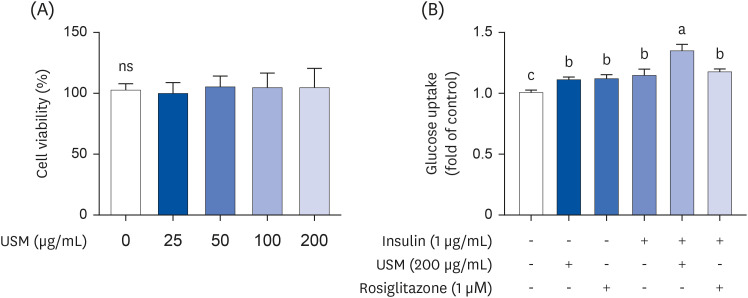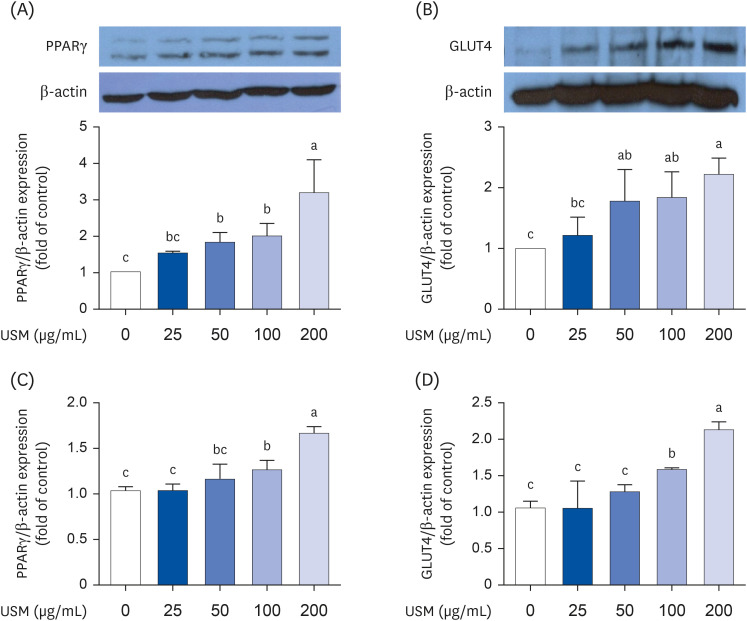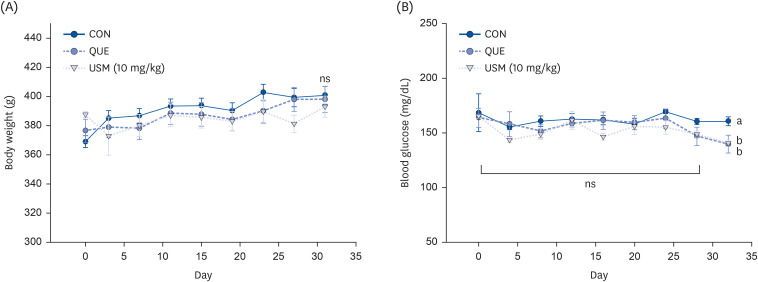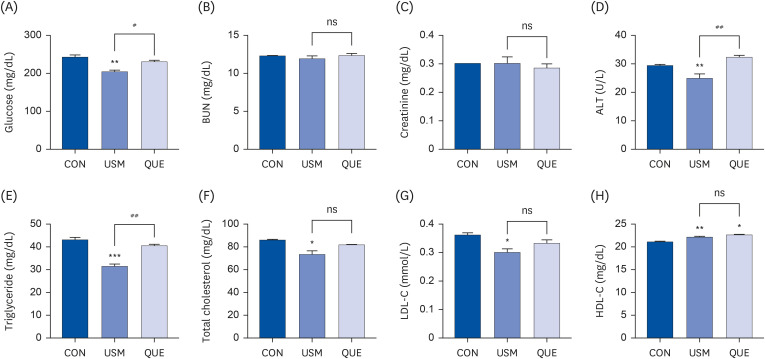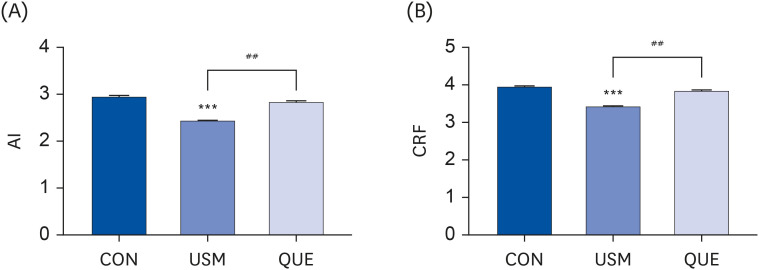Nutr Res Pract.
2024 Jun;18(3):345-356. 10.4162/nrp.2024.18.3.345.
Hypoglycemic and hypolipidemic effects of unsaponifiable matter from okra seed in diabetic rats
- Affiliations
-
- 1Department of Food Science and Biotechnology, Kyungsung University, Busan 48434, Korea
- 2College of Pharmacy, Kyungsung University, Busan 48434, Korea
- 3Department of GreenBio Science/Food Science and Technology, Gyeongsang National University, Jinju 52725, Korea
- 4Department of Food Science and Biotechnology, Chungbuk National University, Cheongju 28644, Korea
- KMID: 2558508
- DOI: http://doi.org/10.4162/nrp.2024.18.3.345
Abstract
- BACKGROUND/OBJECTIVES
Okra seed is a rich source of various nutritional and bioactive constituents, but its mechanism of action is still unclear. The aim of this study was to evaluated the effects on glucose uptake and serum lipid profiles of unsaponifiable matter (USM) from okra seed in adipocytes and diabetic animal models.
MATERIALS/METHODS
USM was prepared from okra seed powder by saponification. The contents of phytosterols and vitamin E in USM were measured. 3T3-L1 preadipocytes were cultured for 6 days with different concentrations of USM (0–200 μg/mL). The diabetic rats were administered with or without USM for 5 wk.
RESULTS
In the USM, the contents of phytosterols and vitamin E were 394.13 mg/g USM and 31.16 mg/g USM, respectively. USM showed no cytotoxicity and led to an approximately 1.4-fold increase in glucose uptake in 3T3-L1 adipocytes. The treatment of USM also increased the expressions of peroxisome proliferator-activated receptor-γ and glucose transporter-4 in a dose-dependent manner in adipocytes. The body weight change was not significantly different in all diabetic rats. However, blood glucose and the weights of liver and adipose tissues were significantly reduced compared to those in the control diabetic rats. Treatment with USM decreased the levels of triglycerides, total cholesterol, and low-density lipoprotein cholesterol compared to the control group. The USM group also showed significantly decreased atherogenic indices and cardiac risk factors.
CONCLUSION
These results suggest that USM from okra seed improves the hypoglycemic and hypolipidemic effects in diabetic rats, and provides valuable information for improving the functional properties of okra seed.
Keyword
Figure
Reference
-
1. Devalaraja S, Jain S, Yadav H. Exotic fruits as therapeutic complements for diabetes, obesity and metabolic syndrome. Food Res Int. 2011; 44:1856–1865. PMID: 21857774.2. Lois K, Kumar S. Obesity and diabetes. Endocrinol Nutr. 2009; 56(Suppl 4):38–42. PMID: 20629230.3. Nawrocki AR, Scherer PE. Keynote review: the adipocyte as a drug discovery target. Drug Discov Today. 2005; 10:1219–1230. PMID: 16213414.4. Vázquez-Vela ME, Torres N, Tovar AR. White adipose tissue as endocrine organ and its role in obesity. Arch Med Res. 2008; 39:715–728. PMID: 18996284.5. Booth A, Magnuson A, Fouts J, Foster MT. Adipose tissue: an endocrine organ playing a role in metabolic regulation. Horm Mol Biol Clin Investig. 2016; 26:25–42.6. Chukwuma CI, Mopuri R, Nagiah S, Chuturgoon AA, Islam MS. Erythritol reduces small intestinal glucose absorption, increases muscle glucose uptake, improves glucose metabolic enzymes activities and increases expression of Glut-4 and IRS-1 in type 2 diabetic rats. Eur J Nutr. 2018; 57:2431–2444. PMID: 28770335.7. Zhu K, Nie S, Li C, Lin S, Xing M, Li W, Gong D, Xie M. A newly identified polysaccharide from Ganoderma atrum attenuates hyperglycemia and hyperlipidemia. Int J Biol Macromol. 2013; 57:142–150. PMID: 23500445.8. Parikh NH, Parikh PK, Kothari C. Indigenous plant medicines for health care: treatment of diabetes mellitus and hyperlipidemia. Chin J Nat Med. 2014; 12:335–344. PMID: 24856756.9. Shaik Mohamed Sayed UF, Moshawih S, Goh HP, Kifli N, Gupta G, Singh SK, Chellappan DK, Dua K, Hermansyah A, Ser HL, et al. Natural products as novel anti-obesity agents: insights into mechanisms of action and potential for therapeutic management. Front Pharmacol. 2023; 14:1182937. PMID: 37408757.10. Karri S, Sharma S, Hatware K, Patil K. Natural anti-obesity agents and their therapeutic role in management of obesity: a future trend perspective. Biomed Pharmacother. 2019; 110:224–238. PMID: 30481727.11. Islam MT. Phytochemical information and pharmacological activities of Okra (Abelmoschus esculentus): a literature-based review. Phytother Res. 2019; 33:72–80. PMID: 30346086.12. Elkhalifa AE, Alshammari E, Adnan M, Alcantara JC, Awadelkareem AM, Eltoum NE, Mehmood K, Panda BP, Ashraf SA. Okra (Abelmoschus esculentus) as a potential dietary medicine with nutraceutical importance for sustainable health applications. Molecules. 2021; 26:696. PMID: 33525745.13. Afinisha Deepam LS, Arumughan C. Effect of saponification on composition of unsaponifiable matter in rice bran oil. J Oleo Sci. 2012; 61:241–247. PMID: 22531051.14. Sharma RD, Rukmini C. Hypocholesterolemic activity of unsaponifiable matter of rice bran oil. Indian J Med Res. 1987; 85:278–281. PMID: 3610272.15. Lee H, Sung J, Kim Y, Jeong HS, Lee J. Protective effects of unsaponifiable matter from perilla seed meal on UVB-induced damages and the underlying mechanisms in human skin fibroblasts. Antioxidants (Basel). 2019; 8:644. PMID: 31847198.16. Seo D, Jeon A, Shin EC, Lee J, Hwang IG, Kim Y. Evaluation of bioactive compounds contents and biological activities of okra seeds oils. J Korean Soc Food Cult. 2020; 35:392–399.17. Shin EC, Pegg RB, Phillips RD, Eitenmiller RR. Commercial peanut (Arachis hypogaea L.) cultivars in the United States: phytosterol composition. J Agric Food Chem. 2010; 58:9137–9146. PMID: 20677801.18. Yeon J, Lee J, Kim Y. Comparison of phytochemical contents and cytoprotective effects of different rice bran extracts from Indica and Japonica rice cultivars. Prev Nutr Food Sci. 2020; 25:432–439. PMID: 33505937.19. Kim Y, Park Y, Namkoong S, Lee J. Esculetin inhibits the inflammatory response by inducing heme oxygenase-1 in cocultured macrophages and adipocytes. Food Funct. 2014; 5:2371–2377. PMID: 25088305.20. Kim Y, Lee J. Effect of (-)-epigallocatechin-3-gallate on anti-inflammatory response via heme oxygenase-1 induction during adipocyte-macrophage interactions. Food Sci Biotechnol. 2016; 25:1767–1773. PMID: 30263473.21. Ham H, Sung J, Lee J. Effect of rice bran unsaponifiables on high‐fat diet‐induced obesity in mice. J Food Biochem. 2015; 39:673–681.22. Zhao L, Zhang Q, Ma W, Tian F, Shen H, Zhou M. A combination of quercetin and resveratrol reduces obesity in high-fat diet-fed rats by modulation of gut microbiota. Food Funct. 2017; 8:4644–4656. PMID: 29152632.23. Peng J, Li Q, Li K, Zhu L, Lin X, Lin X, Shen Q, Li G, Xie X. Quercetin improves glucose and lipid metabolism of diabetic rats: involvement of Akt signaling and SIRT1. J Diabetes Res. 2017; 2017:3417306. PMID: 29379801.24. Kang NH, Lee WK, Yi BR, Lee HR, Park MA, Park SK, Park HK, Choi KC. Risk of cardiovascular disease is suppressed by dietary supplementation with protamine and chitooligosaccharide in Sprague-Dawley rats. Mol Med Rep. 2013; 7:127–133. PMID: 23064235.25. Expert Panel on Detection, Evaluation, and Treatment of High Blood Cholesterol in Adults. Executive Summary of The Third Report of The National Cholesterol Education Program (NCEP) Expert Panel on Detection, Evaluation, And Treatment of High Blood Cholesterol In Adults (Adult Treatment Panel III). JAMA. 2001; 285:2486–2497. PMID: 11368702.26. de Jong A, Plat J, Mensink RP. Metabolic effects of plant sterols and stanols (Review). J Nutr Biochem. 2003; 14:362–369. PMID: 12915216.27. Tanaka M, Misawa E, Ito Y, Habara N, Nomaguchi K, Yamada M, Toida T, Hayasawa H, Takase M, Inagaki M, et al. Identification of five phytosterols from Aloe vera gel as anti-diabetic compounds. Biol Pharm Bull. 2006; 29:1418–1422. PMID: 16819181.28. Ham H, Yoon SW, Kim IH, Kwak J, Lee JS, Jeong HS, Lee J. Protective effects of unsaponifiable matter from rice bran on oxidative damage by modulating antioxidant enzyme activities in HepG2 cells. Lebensm Wiss Technol. 2015; 61:602–608.29. An M, Heo H, Park J, Jeong HS, Kim Y, Lee J. Unsaponifiable matter from wheat bran cultivated in Korea inhibits hepatic lipogenesis by activating AMPK pathway. Foods. 2023; 12:4016. PMID: 37959135.30. Comitato R, Ambra R, Virgili F. Tocotrienols: a family of molecules with specific biological activities. Antioxidants (Basel). 2017; 6:93. PMID: 29156559.31. Paolisso G, D’Amore A, Giugliano D, Ceriello A, Varricchio M, D’Onofrio F. Pharmacologic doses of vitamin E improve insulin action in healthy subjects and non-insulin-dependent diabetic patients. Am J Clin Nutr. 1993; 57:650–656. PMID: 8480681.32. Hwang SL, Kim HN, Jung HH, Kim JE, Choi DK, Hur JM, Lee JY, Song H, Song KS, Huh TL. Beneficial effects of beta-sitosterol on glucose and lipid metabolism in L6 myotube cells are mediated by AMP-activated protein kinase. Biochem Biophys Res Commun. 2008; 377:1253–1258. PMID: 18992226.33. Sujatha S, Anand S, Sangeetha K, Shilpa K, Lakshmi J, Balakrishnan A, Lakshmi B. Biological evaluation of (3β)-STIGMAST-5-EN-3-OL as potent anti-diabetic agent in regulating glucose transport using in vitro model. Int J Diabetes Mellit. 2010; 2:101–109.34. Balbi ME, Tonin FS, Mendes AM, Borba HH, Wiens A, Fernandez-Llimos F, Pontarolo R. Antioxidant effects of vitamins in type 2 diabetes: a meta-analysis of randomized controlled trials. Diabetol Metab Syndr. 2018; 10:18. PMID: 29568330.35. Prabhakar PK, Doble M. Synergistic effect of phytochemicals in combination with hypoglycemic drugs on glucose uptake in myotubes. Phytomedicine. 2009; 16:1119–1126. PMID: 19660925.36. Wilson TA, Nicolosi RJ, Woolfrey B, Kritchevsky D. Rice bran oil and oryzanol reduce plasma lipid and lipoprotein cholesterol concentrations and aortic cholesterol ester accumulation to a greater extent than ferulic acid in hypercholesterolemic hamsters. J Nutr Biochem. 2007; 18:105–112. PMID: 16713234.37. Zhu Y, Sang S. Phytochemicals in whole grain wheat and their health-promoting effects. Mol Nutr Food Res. 2017; 61:1600852.38. Goldberg DM, Watts C. Serum enzyme changes as evidence of liver reaction to oral alcohol. Gastroenterology. 1965; 49:256–261. PMID: 5318690.39. Asagba SO, Kadiri HE, Ezedom T. Biochemical changes in diabetic rats treated with ethanolic extract of Chrysophyllum albidum fruit-skin. J Basic Appl Zool. 2019; 80:42.40. Kannel WB, Dawber TR, Friedman GD, Glennon WE, McNamara PM. Risk factors in coronary heart disease: an evaluation of several serum lipids as predictors of coronary heart disease; the Framingham study. Ann Intern Med. 1964; 61:888–899. PMID: 14233810.41. Gordon T, Kannel WB, Castelli WP, Dawber TR. Lipoproteins, cardiovascular disease, and death: the Framingham study. Arch Intern Med. 1981; 141:1128–1131. PMID: 7259370.42. Stamler J, Wentworth D, Neaton JD. Prevalence and prognostic significance of hypercholesterolemia in men with hypertension. Prospective data on the primary screenees of the multiple risk factor intervention trial. Am J Med. 1986; 80:33–39. PMID: 3946459.43. Babu S, Krishnan M, Rajagopal P, Periyasamy V, Veeraraghavan V, Govindan R, Jayaraman S. Beta-sitosterol attenuates insulin resistance in adipose tissue via IRS-1/Akt mediated insulin signaling in high fat diet and sucrose induced type-2 diabetic rats. Eur J Pharmacol. 2020; 873:173004. PMID: 32045603.44. Krishnan M, Babu S, Rajagopal P, Nazar SP, Chinnaiyan M, Jayaraman S. Effect of β-sitosterol on insulin receptor, glucose transporter 4 protein expression and glucose oxidation in the gastrocnemius muscle of high fat diet induced type -2 diabetic experimental rats. Indian J Pharm Educ Res. 2021; 55:s479–s491.45. Shirpoor A, Norouzi L, Nemati S, Khadem Ansari MH. Protective effect of vitamin E against diabetes-induced oxidized LDL and aorta cell wall proliferation in rat. Iran Biomed J. 2015; 19:117–123. PMID: 25864817.
- Full Text Links
- Actions
-
Cited
- CITED
-
- Close
- Share
- Similar articles
-
- Effects of Benincasa hispida Seeds Intake on Blood Glucose and Lipid Levels in Streptozotocin Induced Diabetic Rats
- Hypolipidemic and hypoglycemic effects of Orostachys japonicus A. Berger extracts in streptozotocin-induced diabetic rats
- The antidiabetic effects of an herbal formula composed of Alnus hirsuta, Rosa davurica, Acanthopanax senticosus and Panax schinseng in the streptozotocin-induced diabetic rats
- Verticillium Wilt of Okra Caused by Verticillium dahliae Kleb. in China
- Hypoglycemic and hypolipidemic effects of Saururus chinensis Baill in streptozotocin-induced diabetic rats

